If you’re considering a diamond for your ring, the cushion cut combines the best of both the old and new worlds. However, there are some misconceptions surrounding this diamond shape.
In this article, we aim to clarify the differences between antique cushion cut and modern cushion cut diamonds. Our objective is to provide insights into this beautiful diamond shape and offer guidance on what to consider when buying a cushion cut diamond.
Without delay, let’s delve into the world of cushion cut diamonds and explore their unique characteristics.
DESIGN YOUR OWN ENGAGEMENT RING: START WITH A SETTING OR START WITH A DIAMOND. IT’S REALLY UP TO YOU!

What Is A Cushion Cut Diamond
The cushion cut is a diamond shape that combines elements of the modern round brilliant cut with the classic Old Mine cut. It typically features a square or rectangular shape with gently curved edges.
The name “cushion” comes from the diamond’s resemblance to a soft pillow due to its rounded corners and square shape.
While cushion-cut diamonds are commonly chosen for engagement rings, they are also used in various fashion jewelry pieces.
Compared to round brilliant cut diamonds, cushion-cut diamonds are often more affordable. However, as the popularity of cushion cuts increases, prices can vary and even experience significant increases. This is a common trend with popular and in-demand products, including diamonds.
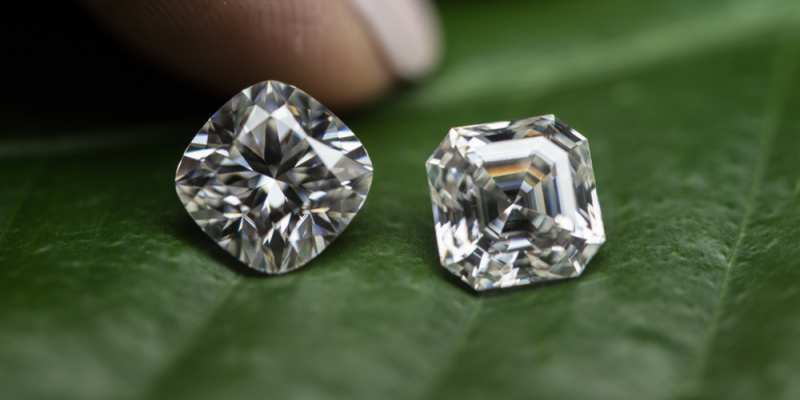
Cushion-Cut Diamonds: Pros & Cons
Like all diamond shapes, the cushion-cut diamond has its own set of advantages and disadvantages. Take a look at the pros and cons listed below to determine if this diamond shape suits your preferences:
Pros:
- High level of fire and brilliance: Cushion-cut diamonds exhibit excellent sparkle and brilliance, creating a captivating display of light.
- Unique shape for a personalized ring: The distinctive shape of a cushion-cut diamond adds a touch of individuality to your ring, making it stand out from more common shapes.
- Durability due to rounded edges: The rounded edges of a cushion-cut diamond make it more resistant to chipping and damage compared to diamonds with sharp corners.
- Combines classic fashion with modern flair: The cushion cut combines the timeless elegance of vintage cuts with a modern aesthetic, resulting in a versatile and stylish choice.
- Cost-effective compared to round brilliant cut diamonds: Generally, cushion-cut diamonds are less expensive per carat than round brilliant cut diamonds, allowing you to get a larger stone for your budget.
- Increasing popularity: The popularity of cushion-cut diamonds has been on the rise, making them a trendy and sought-after choice.
Cons:
- Retains color more than other diamond shapes: Cushion-cut diamonds may exhibit more color compared to other shapes, so it’s important to consider the diamond’s color grade when selecting a stone.
- Imperfections are more noticeable: The open table and large facets of cushion-cut diamonds can make inclusions and flaws more visible, requiring careful consideration of clarity grade.
- Different terminology can cause confusion: The cushion cut is often referred to by various names such as classic cushion, modified cushion, or chunky cushion, which can lead to confusion or variations in expectations.
Considering these pros and cons will help you make an informed decision when considering a cushion-cut diamond for your jewelry.
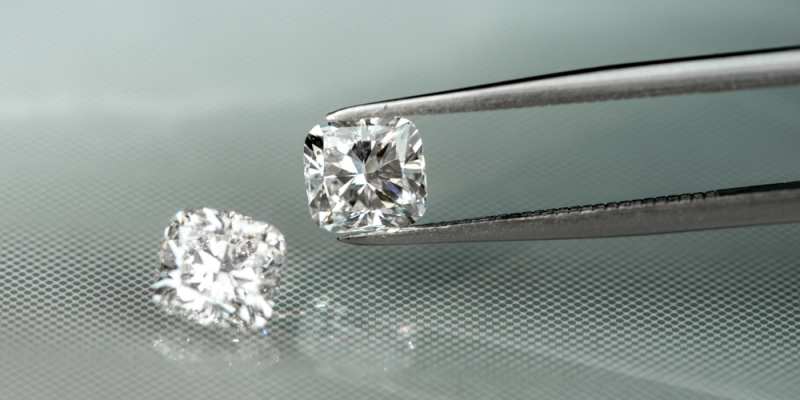
GIA Certifications For Cushion-Cut Diamonds
Before finalizing your purchase of a cushion cut diamond, it is crucial to carefully examine its certification. Like with any diamond or gemstone, it is recommended to choose diamonds that are certified by the Gemological Institute of America (GIA), which is widely regarded as the most trusted and reputable gemological lab globally.
GIA certification ensures that the diamond has undergone a thorough evaluation, including an assessment of its carat weight, cut quality, color grade, clarity grade, and other important factors. The detailed information about these characteristics is documented in the diamond’s certificate, providing you with a reliable and independent appraisal of the stone you intend to purchase.
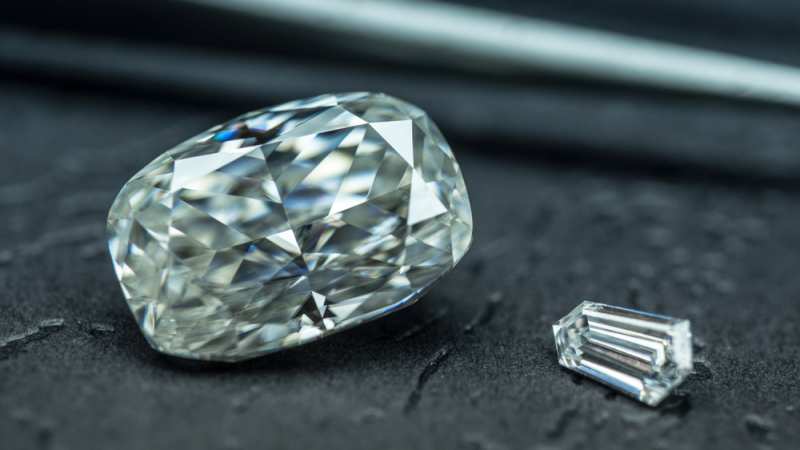
How To Choose A Cushion-Cut Diamond
If you’re considering purchasing a cushion-cut diamond, it’s important to be aware of key factors to consider and compare when selecting the right stone. Here are the critical aspects to look for:
Cushion-Cut Diamonds: Color
Cushion cuts tend to retain more color compared to other diamond shapes. For optimal results, we recommend choosing an H color grade or better, unless the diamond will be set in rose or yellow gold. In that case, a J or K color grade can be suitable. H color is an excellent value choice, offering a balance between cost and diamond color. While H color diamonds are not entirely colorless, they are considered “near-colorless” and typically exhibit only a subtle yellow tint that is hardly noticeable, especially when set in rose or yellow gold.
Cushion-Cut Diamond: Clarity
For the best value, sticking to SI2 or SI1 clarity grades is recommended for cushion-cut diamonds. However, due to their large, open table, finding an eye-clean SI2 clarity diamond might be challenging. You may need to compromise and pay more for a higher clarity grade stone.
Cushion-Cut Diamond: Cut Parameters
When it comes to cut parameters for cushion-cut diamonds, the guidelines are relatively loose:
- Depth: Aim for under 70%
- Table: Aim for under 70%
- Polish and symmetry: Good, Very Good, or Excellent
- Length-to-width ratio: Choose based on personal preference
It’s important to note that the cut quality of cushion-cut diamonds cannot be determined solely by numerical values. Recommendations from experts can be valuable in selecting the right stone.
The length-to-width ratio indicates the proportional dimensions of the diamond and can affect its appearance when viewed face-up.
Polish refers to the quality of the diamond’s facet polishing, while symmetry assesses the alignment of the diamond’s facets. Both polish and symmetry should have a minimum grade of Very Good.
Additionally, carat weight plays a significant role in the price of cushion-cut diamonds. As carat weight increases, prices tend to rise, as larger diamonds are often more desirable for engagement rings and other jewelry.
By considering these factors and seeking expert guidance, you can make an informed decision when choosing a cushion-cut diamond.
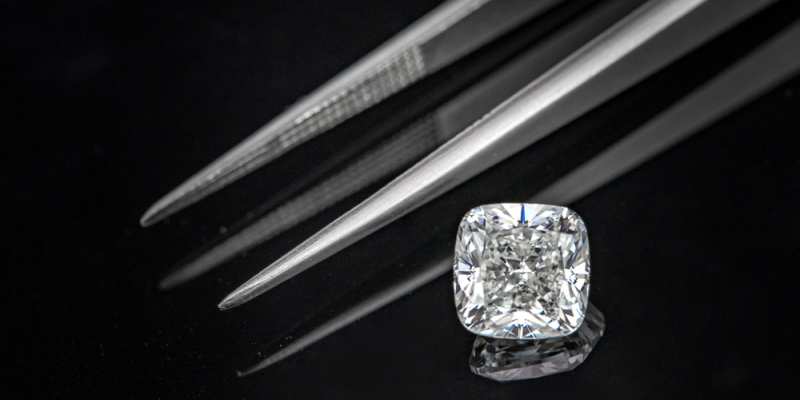
The Misunderstood Cushion Cut
After round brilliants and princess cuts, one diamond shape that has gained significant popularity in recent times is the cushion cut. There are two main reasons for this surge in interest.
First, cushion-cut diamonds have become more popular than ever before. These gems manage to strike a balance between understated elegance and a high level of brilliance, much like round brilliant cut diamonds.
Second, cushion cut diamonds can be quite confusing due to the various terms associated with them. It’s important to understand terms like classic cushions, modified cushions, broken glass chunky cushions, “crushed ice,” Old Mine cut, square cushions, and rectangular cushions. These terms describe different variations of cushion cuts, but many people are unaware of their specific characteristics and advantages.
When it comes to antique cushion cuts, also known as Old Mine cuts, they feature smaller tables, bigger culets, and steeper crowns. This vintage cutting style appeals to consumers because of its timeless and classic appearance. On the other hand, modern cushion cuts have larger tables, smaller culets, and better cut angles, resulting in improved brilliance.
Modern cushion cut diamonds can be further classified as either standard or modified. The differences between these two categories are relatively small and technical, with minimal impact on the diamond’s appearance. The distinction between them lies mainly in their history, as standard cushion cuts have been around for a longer time, while modified cushion cuts are a more contemporary version of the original cut.
It’s important to debunk a common misconception about cushion cut diamonds. Some may claim that choosing a “standard cushion cut” will give you a “chunky” cushion appearance, while a modified cushion cut will result in a “crushed ice” appearance. However, this is not accurate, as the cut classification does not necessarily determine the stone’s visual appearance.
In terms of appearance, cushion-cut diamonds can be categorized into two groups: “chunky” and “crushed ice.” Chunky cushion cuts exhibit clear facet patterns when viewed face-up, resembling antique cushion cuts or round brilliants. The term “antique cushion cut” is used to describe this appearance, although technically, cushion brilliants are more modern, and the actual antique cut is the Old Mine cut. On the other hand, crushed-ice cushion cuts do not display discernible facets when viewed through the table, giving the impression of broken glass or crushed ice. This effect is commonly found in radiant-cut diamonds, as well as in the corners of pear-shaped and marquise-shaped diamonds.
To distinguish between these two appearances, you can observe two diamond shapes that best represent each category: radiant cut for “crushed ice” and round brilliant cut for “chunky” cushion diamonds.
Cushion-cut diamonds are particularly popular as center stones in vintage-style halo rings. They are also sought after for cushion-cut solitaire engagement rings, which feature a single diamond without additional gemstones. Both styles are appealing and cater to different personal preferences.
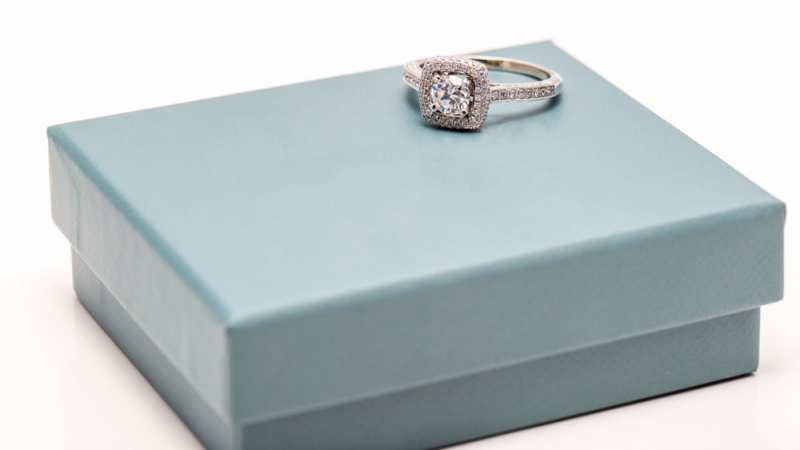
Cushion-Cut Vs. Round Brilliant Cut
If you’re still unsure whether to choose a cushion-cut diamond or a round brilliant cut diamond, consider the following points:
- Shape: Cushion cut diamonds have a square shape with slightly rounded corners. From a distance, they may appear similar to round brilliant cut diamonds, but upon closer inspection, you can distinguish the square shape and rounded edges of a cushion cut.
- Price: Cushion-cut diamonds are generally less expensive per carat compared to round brilliant cut diamonds. Round brilliant cuts tend to have the highest price per carat among all diamond shapes.
- Brilliance: Round brilliant-cut diamonds are renowned for their exceptional brilliance. They exhibit a high level of sparkle and fire. While cushion cuts may not match the exact brilliance of round diamonds, they still offer a significant amount of brilliance and beauty.
- Popularity: Round brilliant-cut diamonds are the most popular choice, with approximately 60% of all diamonds sold in the market being round brilliants. If you prefer a diamond shape that stands out and is less common, a cushion cut may be the ideal choice for you.
- Uniqueness: Cushion-cut diamonds have a unique charm due to their slightly rounded edges. They offer a blend of classic elegance and modern flair. Despite their increasing popularity, cushion cuts retain a sense of uniqueness and individuality.
Consider these factors when making your decision to ensure you choose the diamond shape that best aligns with your personal preferences and style.
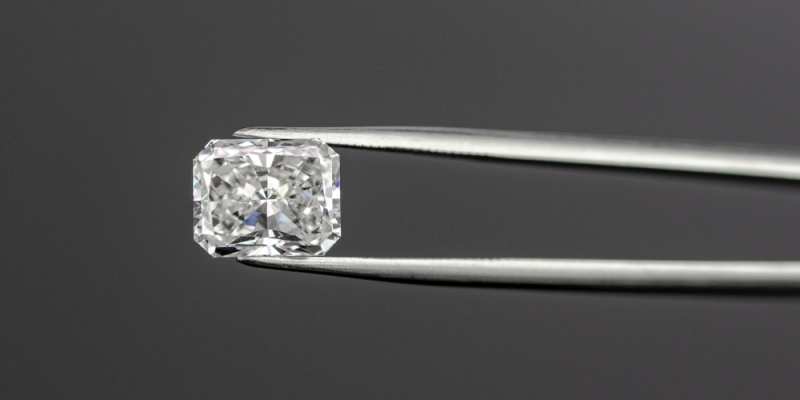
Cushion-Cut Vs. Radiant Cut
When comparing cushion cut diamonds and radiant cut diamonds, there are a few important factors to consider:
- Durability: Both cushion and radiant cuts feature beveled corners, which enhance their durability and stability. The trimmed edges help protect the diamond from chipping or damage.
- Corner Shape: Cushion cut diamonds have rounded corners, while radiant cut diamonds have distinct, sharp edges. This distinction in corner shape gives each diamond a unique appearance.
- Brilliance: Radiant cut diamonds tend to offer more brilliance than cushion cuts. The larger table (top surface) and numerous facets of radiant cuts allow for enhanced light reflection and sparkle. However, cushion-cut diamonds still exhibit considerable brilliance and should not be underestimated in this aspect.
- Shape Variation: Cushion and radiant cuts are available in various square and rectangular compositions. However, cushion-cut diamonds tend to be more square in shape overall. The length-to-width ratio of cushions typically falls within the range of 1.0-1.09, offering a square or slightly elongated appearance.
- Personal Preference: Ultimately, the choice between cushion and radiant cuts comes down to personal preference, taste, and style. Both shapes have their unique qualities and visual appeal. Consider your individual preferences and the aesthetic you desire when making your decision.
Take into account these factors to help you choose between cushion cut and radiant cut diamonds, ensuring that your selection aligns with your personal preferences and desired style.
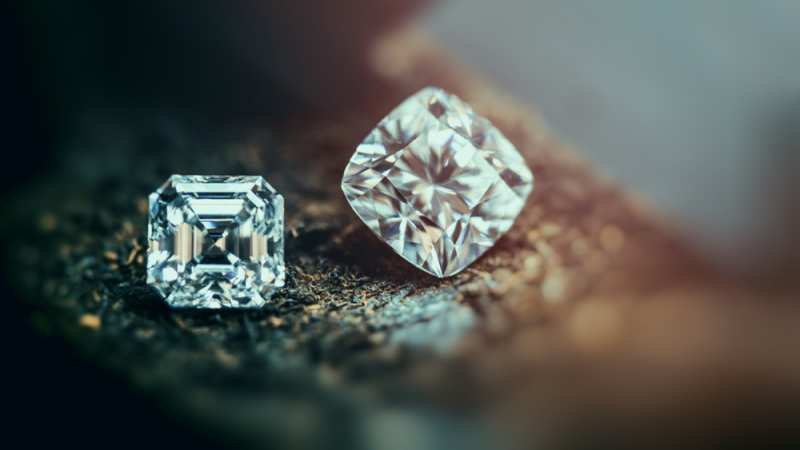
Bottom Line
When searching for cushion-cut diamonds, it’s important to be aware of the common misconceptions surrounding this stunning diamond shape.
The numerous terms associated with cushion cuts can be confusing for some, so it’s understandable if you’re unsure about what you’re dealing with. Terms like modified cushions, classic cushions, antique cushions, and modern cushions can add to the confusion. Among these, the comparison of antique cushion cut vs. modern cushion cut seems to cause the most confusion.
Antique cushions, also known as Old Mine cuts, typically have larger culets, smaller tables, and steeper crowns. On the other hand, modern cushions feature smaller culets, larger tables, and improved cut angles that enhance their brilliance.
Ultimately, the choice between antique cushion cuts and modern cushion cuts is up to you and your personal preferences.


